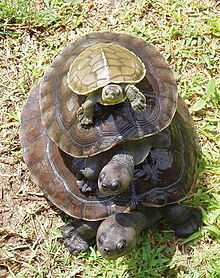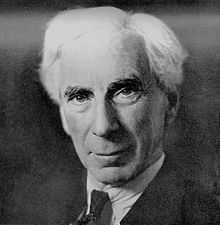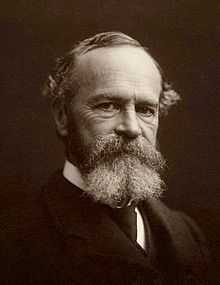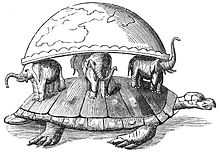Turtles all the way down

"Turtles all the way down" is a jocular expression of the infinite regress problem in cosmology posed by the "unmoved mover" paradox. The metaphor in the anecdote represents a popular notion of the myth that Earth is actually flat and is supported on the back of a World Turtle, which itself is propped up by a chain of larger and larger turtles. Questioning what the final turtle might be standing on, the anecdote humorously concludes that it is "turtles all the way down".
The phrase has been commonly known since at least the early 20th century. A comparable metaphor describing the circular cause and consequence for the same problem is the "chicken and egg problem". The same problem in epistemology is known as the Münchhausen trilemma.
History

The origins of the turtle story are uncertain. It has been recorded since the mid 19th century, and may possibly date to the 18th. One recent version appears in Stephen Hawking's 1988 book A Brief History of Time, which starts:
A well-known scientist (some say it was Bertrand Russell) once gave a public lecture on astronomy. He described how the earth orbits around the sun and how the sun, in turn, orbits around the center of a vast collection of stars called our galaxy. At the end of the lecture, a little old lady at the back of the room got up and said: "What you have told us is rubbish. The world is really a flat plate supported on the back of a giant tortoise." The scientist gave a superior smile before replying, "What is the tortoise standing on?" "You're very clever, young man, very clever," said the old lady. "But it's turtles all the way down!"—Hawking, 1988[1]
Hawking's suggested connection to Russell may be due to Russell's 1927 lecture Why I Am Not a Christian. In it, while discounting the First Cause argument intended to be a proof of God's existence, Russell comments:
- "If everything must have a cause, then God must have a cause. If there can be anything without a cause, it may just as well be the world as God, so that there cannot be any validity in that argument. It is exactly of the same nature as the Hindu's view, that the world rested upon an elephant and the elephant rested upon a tortoise; and when they said, 'How about the tortoise?' the Indian said, 'Suppose we change the subject.'"
In John R. Ross's 1967 linguistics dissertation Constraints on Variables in Syntax, the scientist is identified as the Harvard psychologist and philosopher William James. Of the story's provenance, Ross writes:[2]
After a lecture on cosmology and the structure of the solar system, William James was accosted by a little old lady.
"Your theory that the sun is the centre of the solar system, and the earth is a ball which rotates around it has a very convincing ring to it, Mr. James, but it's wrong. I've got a better theory," said the little old lady.
"And what is that, madam?" Inquired James politely.
"That we live on a crust of earth which is on the back of a giant turtle,"
Not wishing to demolish this absurd little theory by bringing to bear the masses of scientific evidence he had at his command, James decided to gently dissuade his opponent by making her see some of the inadequacies of her position.
"If your theory is correct, madam," he asked, "what does this turtle stand on?"
"You're a very clever man, Mr. James, and that's a very good question," replied the little old lady, "but I have an answer to it. And it is this: The first turtle stands on the back of a second, far larger, turtle, who stands directly under him."
"But what does this second turtle stand on?" persisted James patiently.
To this the little old lady crowed triumphantly. "It's no use, Mr. James – it's turtles all the way down."—J. R. Ross, Constraints on Variables in Syntax 1967
The earliest known version of the story in its "turtle" form appeared in 1854, in a transcript of remarks by preacher Joseph Frederick Berg addressed to Joseph Barker:
My opponent's reasoning reminds me of the heathen, who, being asked on what the world stood, replied, "On a tortoise." But on what does the tortoise stand? "On another tortoise." With Mr. Barker, too, there are tortoises all the way down. (Vehement and vociferous applause.)— "Second Evening: Remarks of Rev. Dr. Berg"[3]

Many 20th-century attributions point to William James as the source.[4] James referred to the fable of the elephant and tortoise several times, but told the infinite regress story with "rocks all the way down" in his 1882 essay, "Rationality, Activity and Faith":
Like the old woman in the story who described the world as resting on a rock, and then explained that rock to be supported by another rock, and finally when pushed with questions said it was "rocks all the way down," he who believes this to be a radically moral universe must hold the moral order to rest either on an absolute and ultimate should or on a series of shoulds "all the way down."[5]
In the form of "rocks all the way down", the story predates James to at least 1838, when it was printed in an unsigned anecdote about a schoolboy and an old woman living in the woods:
"The world, marm," said I, anxious to display my acquired knowledge, "is not exactly round, but resembles in shape a flattened orange; and it turns on its axis once in twenty-four hours."
"Well, I don't know anything about its axes," replied she, "but I know it don't turn round, for if it did we'd be all tumbled off; and as to its being round, any one can see it's a square piece of ground, standing on a rock!"
"Standing on a rock! but upon what does that stand?"
"Why, on another, to be sure!"
"But what supports the last?"
"Lud! child, how stupid you are! There's rocks all the way down!"[6]
Background in Hindu mythology

The explicit reference to infinite regression ("all the way down") cannot be shown to predate the 19th century, but in the 17th and 18th centuries, there are references to the story in the form of a World Elephant standing on a World Turtle claimed, without good evidence, to come from Hindu mythology.
Henry David Thoreau, in his journal entry of 4 May 1852,[7] writes:
Men are making speeches... all over the country, but each expresses only the thought, or the want of thought, of the multitude. No man stands on truth. They are merely banded together as usual, one leaning on another and all together on nothing; as the Hindoos made the world rest on an elephant, and the elephant on a tortoise, and had nothing to put under the tortoise.
There is an allusion to the story in David Hume's Dialogues Concerning Natural Religion (published in 1779):
How can we satisfy ourselves without going on in infinitum? And, after all, what satisfaction is there in that infinite progression? Let us remember the story of the Indian philosopher and his elephant. It was never more applicable than to the present subject. If the material world rests upon a similar ideal world, this ideal world must rest upon some other; and so on, without end. It were better, therefore, never to look beyond the present material world.—Hume, 1779[8]
The first known reference to a Hindu source is found in a letter by Jesuit Emanual de Veiga (1549-1605), written at Chandagiri on 18 September 1599, in which the relevant passage reads
- Alii dicebant terram novem constare angulis, quibus cœlo innititur. Alius ab his dissentiens volebat terram septem elephantis fulciri, elephantes uero ne subsiderent, super testudine pedes fixos habere. Quærenti quis testudinis corpus firmaret, ne dilaberetur, respondere nesciuit.
- "Others hold that the earth has nine corners by which the heavens are supported. Another disagreeing from these would have the earth supported by seven elephants, and the elephants do not sink down because their feet are fixed on a tortoise. When asked who would fix the body of the tortoise, so that it would not collapse, he said that he did not know."[9]
Veiga's account seems to have been received by Samuel Purchas, who has a close paraphrase in his Purchas His Pilgrims (1613/1626), "that the Earth had nine corners, whereby it was borne up by the Heaven. Others dissented, and said, that the Earth was borne up by seven Elephants; the Elephants feet stood on Tortoises, and they were borne by they know not what."[10]
Purchas' account is again reflected by John Locke in his 1689 tract An Essay Concerning Human Understanding, introducing the story as attributed to Hindu mythology as a trope referring to the problem of induction in philosophical debate. Locke compares one who would say that properties inherent in "substance" to the Indian who said the world was on an elephant which was on a tortoise "but being again pressed to know what gave support to the broad-backed tortoise, replied — something, he knew not what."[11]
Notable modern allusions or variations
Since the 1980s or so the story or trope has been so well known that frequent references were made in pop culture and popular literature. Many variants now have a "scientist" replying to "a little old lady", the scientist variously taking the identity of Arthur Stanley Eddington, Thomas Huxley, Linus Pauling, or Carl Sagan, etc., although in the 1970s the "Hindu" or "Oriental" background still seems to have received more frequent mention.
Clifford Geertz's, "Thick Description: Towards an Interpretive Theory of Culture", in his 1973 book The Interpretation of Culture still casts the dialogue as taking place between an Englishman and an Indian.[12]
Carl Sagan recited a version of the story as an apocryphal anecdote in his 1979 book Broca's Brain: Reflections on the Romance of Science, as an exchange between a "Western traveler" and an "Oriental philosopher".
Robert Anton Wilson's book Prometheus Rising (1983) opens with the William James version of the story, the punchline being given in the form: "It's turtles-turtles-turtles, all the way!"
The Discworld novels, written by Terry Pratchett (from 1983) involve a fictional flat world which rests on the back of four giant elephants, all of whom stand on the back of a giant World-Turtle called Great A'Tuin. Once when questioned about what the turtle sits on, it is related that the turtle doesn't sit on anything; it swims.
Far-Seer (1992), Part One of Robert J. Sawyer's three-part novel, the Quintaglio Ascension Trilogy, retells the story, replacing turtles with armourbacks (ankylosaurs).
Thomas King uses the story to frame each of his five Massey Lectures collected in The Truth About Stories (2003).
Justice Antonin Scalia of the U.S. Supreme Court discussed his "favored version" of the tale in a footnote to his plurality opinion in Rapanos v. United States (decided June 19, 2006):
In our favored version, an Eastern guru affirms that the earth is supported on the back of a tiger. When asked what supports the tiger, he says it stands upon an elephant; and when asked what supports the elephant he says it is a giant turtle. When asked, finally, what supports the giant turtle, he is briefly taken aback, but quickly replies "Ah, after that it is turtles all the way down."—Antonin Scalia, Antonin Scalia. "RAPANOS v. UNITED STATES". Cornell Law School Legal Information Institute's Supreme Court collection.
"Turtles All the Way Down" is a song on Buffalo hardcore punk band Every Time I Die's fifth studio album New Junk Aesthetic (2009).
In Scott Westerfeld's Behemoth (2010) an Armenian grandmother says the Earth rests on the back of a turtle, which is supported by an elephant (the reverse of Discworld). When challenged by her son about what the elephant stands upon, she says "Don't try to be clever, young man. It's elephants all the way down!"
"Turtles All the Way Down" was the title of the final episode of Awake (2012), and was the final line of the female psychiatrist at the end.
"Turtles All the Way Down" is a song by country outlaw artist Sturgill Simpson, which discusses human understanding of space and time. It appears on his 2014 album Metamodern Sounds in Country Music.[13]
A teacher in Lev Grossman's The Magicians (2009) relays the Russell version of the story while discussing the nature of magic. In the sequel The Magician's Land (2014), the giant turtle cries "It's turtles all the way down" after Janet magically freezes his habitat.
In calculus, "Turtles all the Way Down" refers to repeated applications of the chain rule for multiply-composed functions.
See also
Footnotes
- ↑ Hawking, Stephen (1988). A Brief History of Time. Bantam Books. ISBN 978-0-553-05340-1.
- ↑ John R. Ross (1967). Constraints on variables in syntax. (Doctoral dissertation, Massachusetts Institute of Technology). Available at MIT Theses (http://hdl.handle.net/1721.1/15166). See page iv of the ms., page 4 of the electronic file.
- ↑ Barker, Joseph (1854). Great Discussion on the Origin, Authority, and Tendency of the Bible, between Rev. J. F. Berg, D.D., of Philadelphia, and Joseph Barker, of Ohio. Boston: J. B. Yerrinton & Son, Printers. p. 48.
- ↑ Robert Anton Wilson (1983). Prometheus Rising. Phoenix, AZ: New Falcon Publishers. p. 25. ISBN 1-56184-056-4
- ↑ William, James (July 1882). "Rationality, Activity and Faith". The Princeton Review: 82.
- ↑ "Unwritten Philosophy". New York Mirror 16 (12). 1838-09-15. p. 91.
- ↑ The Picket Line — Excerpts from H.D. Thoreau's journals
- ↑ Dialogues Concerning Natural Religion/Part 4
- ↑ J. Charpentier, 'A Treatise on Hindu Cosmography from the Seventeenth Century (Brit. Mus. MS. Sloane 2748 A).' Bulletin of the School of Oriental Studies, University of London 3(2) (1924), pp. 317-342, citing John Hay, De rebus Japonicis, Indicis, and Peruanis epistulæ recentiores (Antwerp, 1605, p. 803f.)
- ↑ Will Sweetman, Indology mailing list, citing Dieter Henrich, 'Die "wahrhafte Schildkröte"' Hegel-Studien 2 (1963), pp. 281-91, and J. Charpentier, 'A Treatise on Hindu Cosmography from the Seventeenth Century (Brit. Mus. MS. Sloane 2748 A).' Bulletin of the School of Oriental Studies, University of London 3(2) (1924), pp. 317-342.
- ↑ Locke, John (1689). An Essay Concerning Human Understanding, Book II, Chapter XXIII, section 2
- ↑ Geertz, Clifford (1973). The Interpretation of Cultures. New York, NY: Basic Books. pp. 28–29. ISBN 0465097197.
- ↑ http://gardenandgun.com/article/sturgill-simpson-country-philosopher